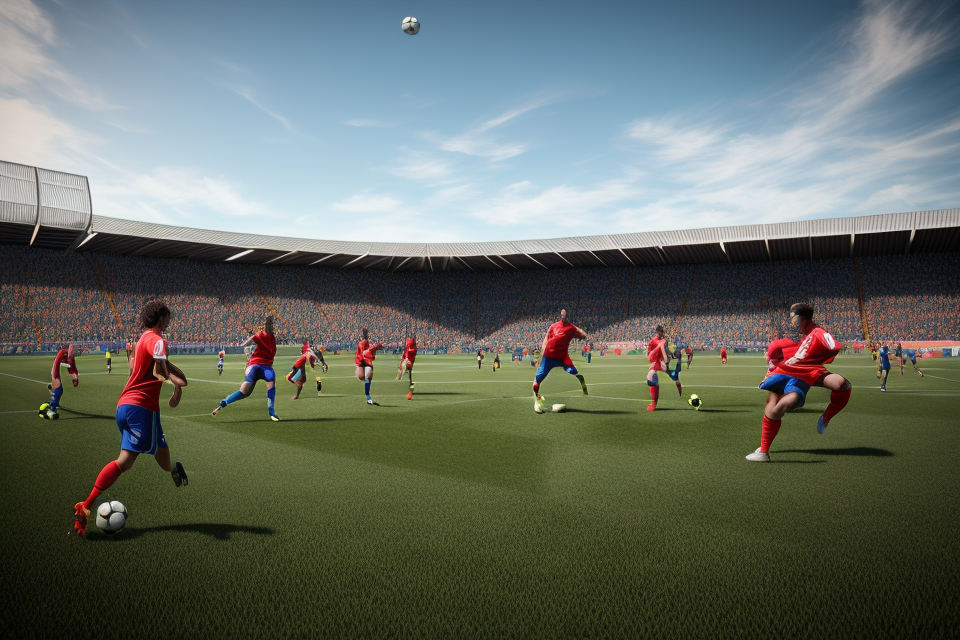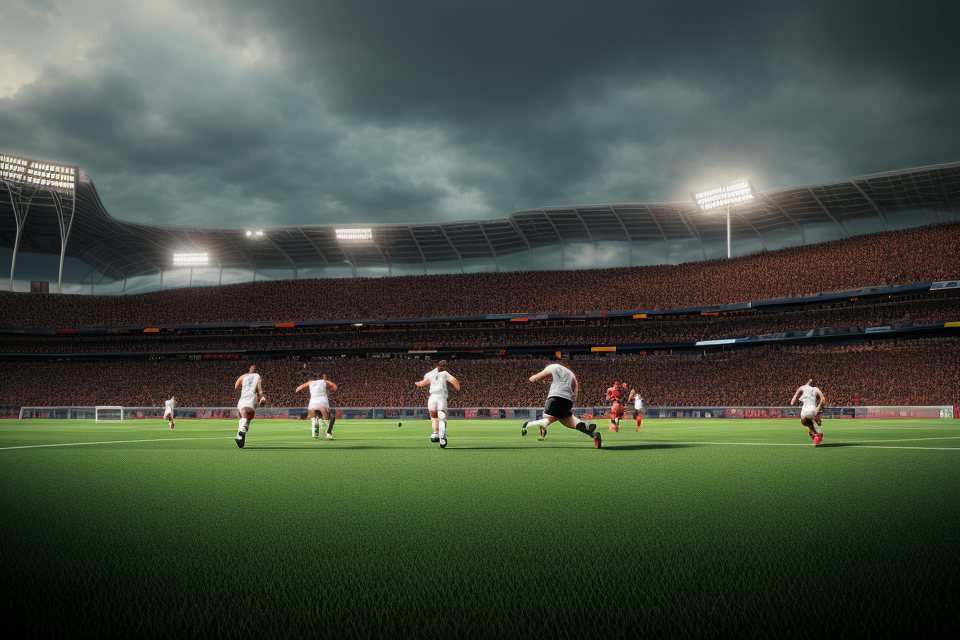Soccer is a physically demanding sport that requires a high level of fitness to perform at your best. Many people wonder if they can improve their soccer performance by simply playing more soccer games. While it’s true that playing soccer regularly can help you build endurance and improve your overall fitness, there are other factors to consider when it comes to achieving peak performance on the field. In this article, we’ll explore the importance of a well-rounded fitness routine and provide tips for improving your soccer skills while also getting in shape. So, lace up your cleats and get ready to learn how to take your soccer game to the next level!
Yes, you can improve your soccer performance by getting fit and physically prepared for the demands of the game. Playing soccer requires a combination of strength, endurance, speed, agility, and coordination, all of which can be developed through a combination of training exercises and regular gameplay. It’s important to incorporate both strength and endurance training into your fitness routine, as well as to focus on developing the specific skills and movements required for soccer. Additionally, a healthy diet and adequate rest and recovery time are crucial for optimal performance on the field. By consistently working on your fitness and conditioning, you can improve your overall soccer performance and enhance your ability to perform at your best during games.
Understanding Soccer Fitness
What is soccer fitness?
Soccer fitness refers to the physical and mental abilities required to perform at an optimal level during a soccer match. It encompasses a range of attributes, including strength, endurance, speed, agility, coordination, and cognitive skills such as decision-making and strategy.
In other words, soccer fitness is the ability to perform various physical tasks and activities that are essential for success in soccer, such as running, jumping, kicking, and passing. It also involves the ability to recover quickly from exertion and maintain focus and concentration throughout the match.
Soccer fitness is important because it allows players to perform at their best for the entire duration of the match, without getting injured or fatigued. It is also essential for preventing injuries, as players who are physically fit are less likely to sustain injuries due to overuse or overexertion.
Overall, soccer fitness is a crucial aspect of improving one’s performance in soccer, and it can be achieved through a combination of training and conditioning, proper nutrition, and adequate rest and recovery.
Components of soccer fitness
To excel in soccer, it is essential to have a comprehensive understanding of the components that make up soccer fitness. These components can be broadly categorized into two types: physical and mental.
- Physical components:
- Endurance: The ability to maintain a high level of intensity for an extended period of time is crucial in soccer. Players need to have the stamina to last through the entire game without getting tired.
- Strength: Physical strength is essential for soccer players as it helps them to tackle, shoot, and pass the ball with power.
- Speed: Soccer players need to be quick on their feet to keep up with the fast-paced nature of the game. Speed also helps players to make sudden movements and changes in direction.
- Agility: Soccer players need to be agile to move quickly and change direction without losing balance. This skill is essential for avoiding tackles and making precise movements on the field.
- Flexibility: Flexibility is important for soccer players as it helps them to perform various movements, such as bending and stretching, without getting injured.
- Mental components:
- Tactical awareness: Soccer players need to have a good understanding of the game and be able to anticipate the movements of their opponents.
- Confidence: Soccer players need to be confident in their abilities to perform well on the field.
- Mental toughness: Soccer players need to be mentally tough to handle the pressure of the game and to bounce back from mistakes.
- Concentration: Soccer players need to be able to concentrate for long periods of time and maintain their focus on the game.
- Leadership: Soccer players need to be able to lead their team and make important decisions on the field.
Key exercises for soccer fitness
As a soccer player, it is essential to have a well-rounded fitness routine that focuses on cardiovascular endurance, strength, and flexibility. These key exercises will help you improve your soccer performance and reduce the risk of injury.
Cardiovascular Exercises
Cardiovascular exercises are essential for building endurance and improving your overall fitness level. Running is one of the most effective exercises for soccer players, as it helps to build both speed and endurance. Other cardiovascular exercises that can be beneficial for soccer players include interval training, cycling, and swimming.
Strength Training Exercises
Strength training exercises are essential for building muscle and improving your overall power on the field. Exercises such as squats, lunges, and deadlifts can help to improve your leg strength and overall lower body power. It is also important to focus on core strength, as a strong core can help you maintain proper form and balance on the field.
Flexibility Exercises
Flexibility exercises are essential for preventing injury and improving your overall range of motion. Stretching is an effective way to improve flexibility, and it is important to focus on stretching the muscles in your legs, hips, and lower back. Yoga and Pilates are also great ways to improve flexibility and core strength.
By incorporating these key exercises into your fitness routine, you can improve your soccer performance and reduce the risk of injury. It is important to work with a coach or personal trainer to develop a personalized fitness plan that meets your individual needs and goals.
Getting Fit Playing Soccer
Benefits of playing soccer for fitness
- Aerobic and anaerobic fitness: Soccer is a sport that requires both aerobic and anaerobic fitness. Aerobic fitness is the ability of the body to utilize oxygen to produce energy during sustained physical activity. Anaerobic fitness, on the other hand, is the ability of the body to produce energy without oxygen during short, intense bursts of activity. Playing soccer regularly can help improve both types of fitness, leading to better endurance and overall physical performance.
- Improved coordination and agility: Soccer involves a lot of movement, including running, jumping, and changing direction quickly. This can help improve coordination and agility, which are important for both soccer performance and overall physical fitness. By regularly playing soccer, you can improve your ability to move your body efficiently and effectively, which can benefit you both on and off the field.
- Weight management: Soccer is a great way to manage weight, as it can help you burn calories and build muscle. Playing soccer regularly can help you maintain a healthy weight or even lose weight, depending on your starting point. Additionally, soccer can help you build muscle mass, which can help you maintain a healthy body composition and improve your overall physical performance.
Tips for getting fit playing soccer
To improve your soccer performance, it is important to get fit playing soccer. Here are some tips to help you achieve this goal:
- Warm-up and cool-down exercises
- Before starting any soccer training session, it is important to warm up your muscles to prevent injury. You can do this by jogging, stretching, or doing light exercises for 5-10 minutes.
- After your training session, it is equally important to cool down your muscles to prevent soreness and improve recovery. You can do this by stretching, foam rolling, or doing light exercises for 5-10 minutes.
- Proper hydration and nutrition
- Dehydration can have a significant impact on your soccer performance, so it is important to stay hydrated before, during, and after your training sessions. Aim to drink at least 8-10 glasses of water per day, and bring a water bottle with you to all your training sessions.
- Additionally, proper nutrition is essential for maintaining energy levels and supporting muscle recovery. Make sure to eat a balanced diet that includes plenty of fruits, vegetables, whole grains, and lean protein.
- Incorporating strength and flexibility exercises into your routine
- To improve your soccer performance, it is important to develop both strength and flexibility. You can do this by incorporating strength exercises such as weightlifting, resistance training, or bodyweight exercises into your routine.
- Additionally, it is important to stretch regularly to improve flexibility and prevent injury. You can do this by stretching your legs, hips, and lower back before and after your training sessions.
By following these tips, you can improve your soccer performance and reduce your risk of injury. Remember to listen to your body and adjust your training routine as needed to achieve your goals.
Developing a Soccer Fitness Program
Setting fitness goals
Setting fitness goals is an essential aspect of developing a soccer fitness program. Goals provide direction and motivation, helping you stay focused on your soccer performance improvements. When setting fitness goals, consider the following guidelines:
- Short-term and long-term goals:
- Short-term goals are immediate objectives that you aim to achieve within a few weeks or months. These goals can be more specific and achievable, such as increasing your sprint speed or improving your endurance.
- Long-term goals are broader objectives that you aim to achieve over a more extended period, usually six months to a year or more. These goals often require consistent effort and may involve more significant improvements, such as reducing your body fat percentage or increasing your overall strength.
- SMART goals:
- SMART is an acronym that stands for Specific, Measurable, Achievable, Relevant, and Time-bound. By setting SMART goals, you ensure that your objectives are clear, realistic, and have a defined timeline for completion.
- Specific: Define your goal clearly, explaining what you want to achieve and why it’s important to you.
- Measurable: Establish criteria for measuring your progress, so you can track your improvements and know when you’ve achieved your goal.
- Achievable: Set goals that are challenging but attainable, considering your current fitness level and resources available to you.
- Relevant: Ensure your goals align with your overall soccer performance improvements and align with your personal and professional aspirations.
- Time-bound: Assign a deadline for achieving your goal, giving you a sense of urgency and motivation to work towards it.
By setting short-term and long-term goals that follow the SMART criteria, you’ll create a comprehensive fitness plan tailored to your soccer performance improvements. This approach will help you stay focused, motivated, and accountable as you progress through your soccer fitness program.
Creating a soccer fitness plan
When it comes to improving your soccer performance, having a well-designed fitness plan is crucial. A soccer fitness plan should focus on both cardiovascular and strength training exercises, while also incorporating plyometrics and agility drills. Periodization and progression are also essential components of an effective soccer fitness plan.
Cardiovascular Training
Cardiovascular training is an essential component of any soccer fitness plan. It helps improve your endurance, which is critical during a soccer match. There are various cardiovascular exercises that you can incorporate into your soccer fitness plan, including running, cycling, and swimming.
When developing your cardiovascular training plan, it’s important to include a variety of exercises to keep things interesting and prevent boredom. For example, you could incorporate interval training, which involves alternating between periods of high-intensity exercise and periods of rest. This type of training has been shown to be highly effective for improving soccer performance.
Strength Training
Strength training is another critical component of a soccer fitness plan. It helps improve your muscular strength and endurance, which is essential for performing at your best on the soccer field. There are various strength training exercises that you can incorporate into your soccer fitness plan, including weightlifting, resistance training, and bodyweight exercises.
When developing your strength training plan, it’s important to focus on exercises that target the muscles used in soccer, such as your legs, core, and upper body. You should also aim to progressively increase the weight or resistance over time to continue challenging your muscles and promoting growth.
Plyometrics and Agility Drills
Plyometrics and agility drills are essential for improving your speed, power, and agility on the soccer field. Plyometrics involve explosive movements that help improve your power and speed, while agility drills help improve your footwork and balance.
There are various plyometric and agility drills that you can incorporate into your soccer fitness plan, including bounding, jump squats, and ladder drills. When developing your plyometric and agility training plan, it’s important to progress gradually to prevent injury and ensure that you’re challenging yourself appropriately.
Periodization and Progression
Periodization and progression are essential components of an effective soccer fitness plan. Periodization involves breaking your training plan into different phases, each with a specific focus. For example, you might have a phase focused on building endurance, a phase focused on building strength, and a phase focused on improving your speed and agility.
Progression involves gradually increasing the intensity and difficulty of your training over time. This helps prevent plateaus and ensures that you continue to improve your soccer performance. When developing your soccer fitness plan, it’s important to have a clear progression strategy in place and to regularly reassess and adjust your plan as needed.
Tracking progress and adjusting the plan
Monitoring progress and performance
To track your progress and performance, it is essential to establish specific and measurable goals. This could include increasing your running speed, improving your endurance, or reducing your body fat percentage. Regularly monitor your progress by tracking your weight, body composition, and fitness test results. It is also important to note any changes in your energy levels, mood, and overall well-being.
Evaluating and adjusting the plan
Once you have established specific and measurable goals, it is important to evaluate your progress regularly. If you are not making progress towards your goals, it may be necessary to adjust your training program. This could involve increasing the intensity of your workouts, modifying your training schedule, or incorporating new exercises to target specific areas of your body. It is also important to periodically review your diet and ensure that you are fueling your body with the necessary nutrients to support your training.
Enhancing Your Soccer Performance with Technology
Using technology to track progress
Soccer is a physically demanding sport that requires players to be in top physical condition to perform at their best. However, traditional methods of tracking fitness and performance, such as keeping a written log or relying on coaches’ observations, can be time-consuming and may not provide accurate or detailed information.
Fortunately, technology has made it easier than ever for soccer players to track their progress and monitor their performance. Fitness trackers and smartwatches are now widely available and can provide players with a wealth of information about their physical activity, including distance covered, calories burned, and heart rate.
These devices can also be used to track specific metrics related to soccer performance, such as sprint distance, ball possession, and passing accuracy. This data can be used to identify areas for improvement and to track progress over time.
In addition to fitness trackers and smartwatches, there are also a variety of apps available that are specifically designed for soccer performance tracking. These apps can provide players with detailed information about their performance on the field, including statistics such as dribbles completed, shots on target, and goals scored.
Some apps even offer personalized training programs and drills that can help players improve their skills and overall fitness. By using technology to track progress, soccer players can gain valuable insights into their performance and take steps to improve their game.
Technology for injury prevention and recovery
As a soccer player, you’re always looking for ways to improve your performance on the field. While training and practicing are essential, injury prevention and recovery are equally important. Fortunately, technology has made it easier than ever to monitor and manage your health, helping you stay in top form throughout the season.
Here are some of the ways technology can help with injury prevention and recovery:
- Foam rolling and self-massage: These techniques can help to loosen tight muscles and improve circulation, reducing your risk of injury. Foam rolling involves using a foam roller to apply pressure to tight muscles, while self-massage involves using your hands to massage sore muscles. Both techniques can be done regularly to help prevent injuries and promote recovery.
- Sports medicine technology: Advances in sports medicine technology have led to the development of innovative products that can help prevent and treat injuries. For example, compression sleeves can help to reduce inflammation and swelling, while knee braces can provide extra support and stability to prevent knee injuries. Other examples include cold therapy devices, which can help to reduce pain and inflammation after a workout, and electrostimulation devices, which can help to speed up the healing process.
By incorporating these technologies into your training routine, you can help to prevent injuries and promote recovery, allowing you to stay in top form throughout the season.
FAQs
1. Is soccer a good way to get fit?
Yes, soccer is a great way to get fit as it involves running, jumping, kicking, and ball control, which all contribute to cardiovascular fitness, muscle strength, and endurance.
2. How can I improve my fitness for soccer?
To improve your fitness for soccer, you should incorporate a combination of endurance training, strength training, and speed work into your fitness routine. You can also consider doing drills that focus on ball control, agility, and reaction time.
3. How many times a week should I train to get fit for soccer?
The frequency of training depends on your current fitness level and goals. However, it is recommended to aim for at least 3-4 sessions per week, with each session lasting at least 60 minutes.
4. Is it necessary to do strength training for soccer?
While soccer primarily involves cardiovascular fitness, strength training can help improve your ability to perform physical tasks on the field, such as making tackles, heading the ball, and sprinting. It can also help prevent injuries.
5. What types of exercises should I do for soccer-specific training?
Soccer-specific training should include exercises that target the muscles used in soccer, such as running, jumping, and changing direction. You can also incorporate drills that focus on ball control, passing, and shooting.
6. Can I get fit for soccer by playing pick-up games?
Playing pick-up games can help improve your soccer fitness, but it may not be enough to achieve specific fitness goals. It is important to incorporate structured training sessions that include a variety of exercises and drills.
7. How can I avoid injuries while training for soccer?
To avoid injuries while training for soccer, it is important to warm up properly before each session, cool down after each session, and stretch regularly. You should also focus on strengthening areas prone to injury, such as the knees and ankles. Additionally, it is important to listen to your body and avoid overtraining.



